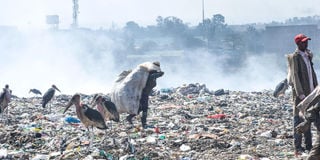City residents’ lives at risk over open burning of waste

The Dandora dumpsite in Nairobi.
What you need to know:
- There are more than 40 slums in the capital city.
- Besides poor infrastructure and sanitation, solid waste is one thing that cannot go unnoticed.
- Unfortunately, most of the waste ends up being burnt or dumped indiscriminately.
Hundreds of thousands, if not millions, of Nairobi residents could be exposed to harmful fumes from open burning of solid waste.
With more than half (60 per cent) of Nairobi residents living in slums, the problem may be much bigger than what is seen.
There are more than 40 slums in the capital city and besides poor infrastructure and sanitation, solid waste is one thing that cannot go unnoticed.
Unfortunately, most of the waste ends up being burnt or dumped indiscriminately, threatening not only the environment but millions of lives through air pollution.
The Dandora dumpsite, for instance, is always smoking, besides a pungent smell felt several kilometres away.
Mutation-causing pollutants
Particulate matter remains highest in Nairobi, with current readings showing it is 70 per cent above the World Health Organization (WHO) recommended maximum level.
A new review on air pollution warns that open burning of solid waste is a global threat to human health and safety which requires urgent action.
The Global Review on Safer End of Engineered Life shows that much of air pollution comes especially from open burning of solid waste and dumpsites.
Researchers examined challenges of open-air burning of waste to work and public safety. They identified ways through which people become exposed to potential harm from plastic waste, medical waste, electronic waste, construction and demolition waste, and land disposal.
They found the most common form of waste management in slums is open air burning. “Participants in the informal waste sector often cause open burning, but the informal workers and their communities, for example in informal settlements, are also most vulnerable to exposure from the associated emissions,” states the report.
This is because waste is burned close to homes, within industrial or commercial premises, and in large uncontrolled dumpsites.
But a hazardous cocktail of emissions released into the atmosphere and onto land “threatens the environment and the health of those who live and work nearby,” states the report.
The review found evidence of emissions from open burning classified as persistent organic pollutants, carcinogenic (cancer-causing), mutagenic (mutation-causing pollutants), those that cause immunological and developmental impairments, and those that may lead to reproductive abnormalities.
This is evident in the number of women who have lost pregnancies in different countries. A report published by the Lancet Planetary Health showed that pregnant women in South Asia who have been exposed to air pollution face an increased risk of pregnancy loss, miscarriage and stillbirth.
Medical waste
Researchers found that an estimated 349,681 pregnancy losses each year across India, Bangladesh and Pakistan were associated with bad air quality.
According to the review, the risk from solid waste are higher in low and middle income countries like Kenya than in developed nations.
It shows that uncontrolled burning of waste was found particularly to be widespread in low- and middle-income countries where collection and disposal systems are often poor or completely absent.
The major global study found widespread use of unsafe management and disposal practices, showing that half a billion tonnes (24 per cent) of all the municipal solid waste generated on earth is not collected. A further 27 per cent is mismanaged following collection, and much of this is disposed of by open burning.
For instance, the combustion of medical waste in most places is rudimentary, which is done in brick-built incinerators.
“While these devices improve combustion temperature in comparison to open burning, they lack auxiliary fuel sources to maintain a sufficiently high temperature and do not incorporate emissions (air pollution) control technology,” said the report.



